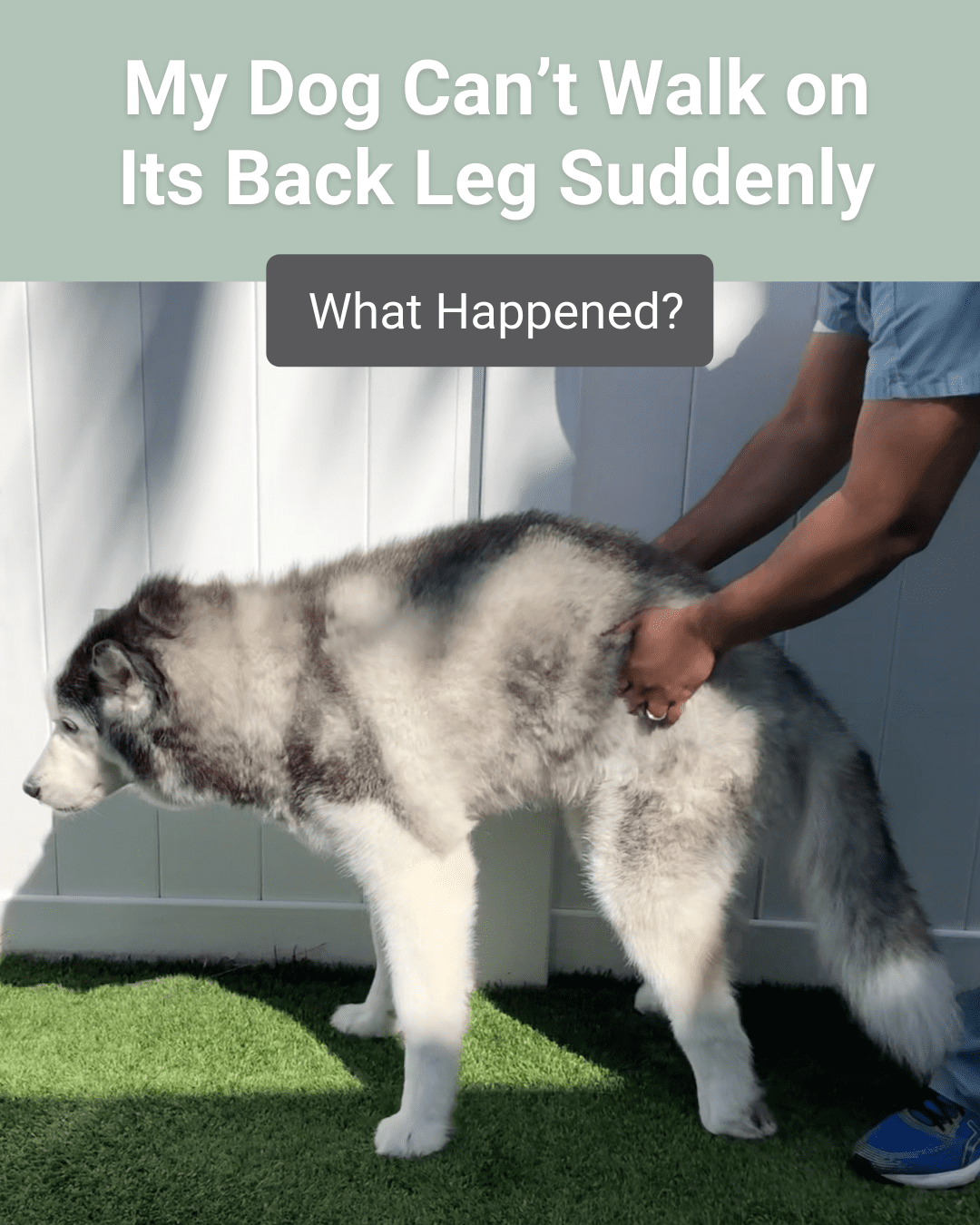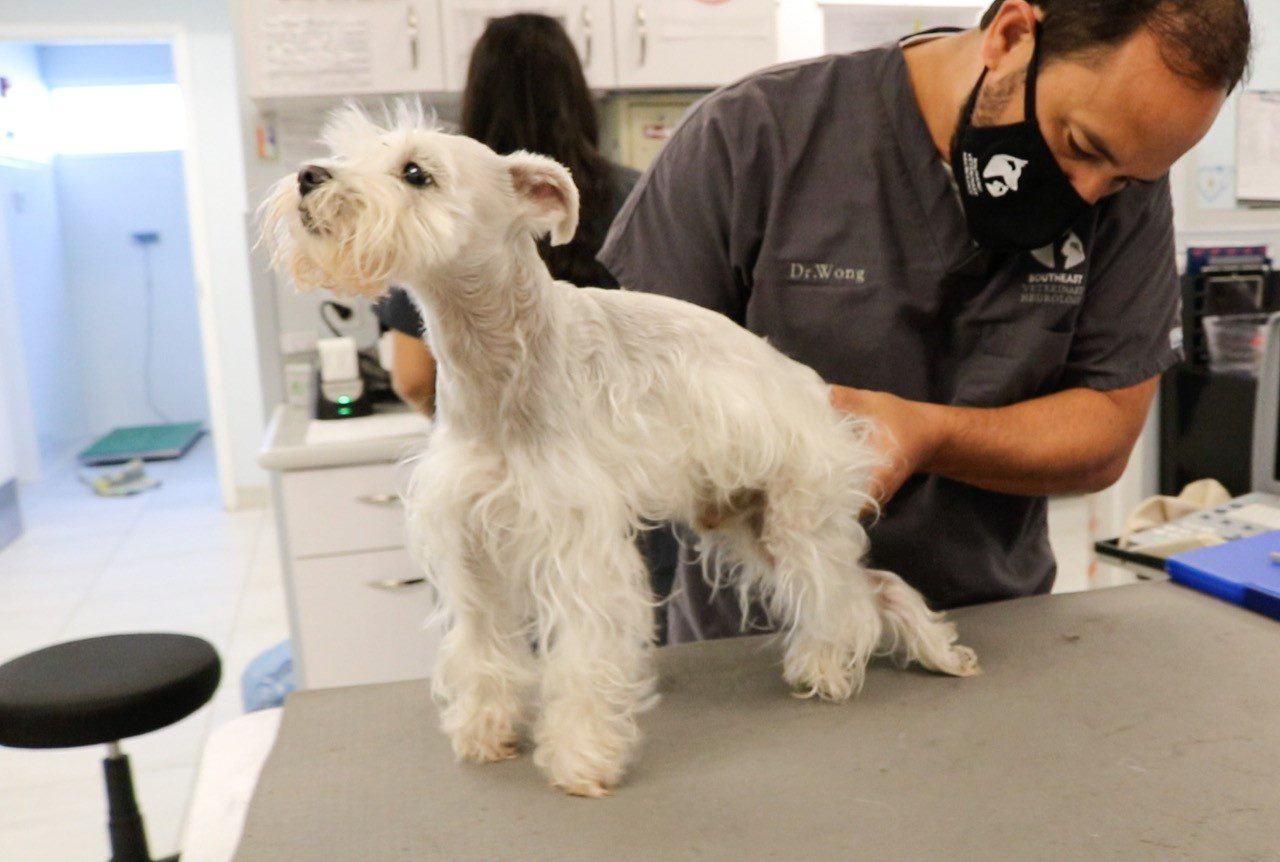When your dog can’t walk on its back leg suddenly and for no reason that you can see, it can be difficult to guess what happened. Some cases of lameness resolve by themselves, but it can also indicate a more serious injury or even an underlying neurological condition.

Things to Consider When Your Dog Can’t Walk on Its Back Leg Suddenly
Lameness can happen gradually or all of a sudden. Gradual, progressive lameness is generally caused by an underlying condition, such as osteoarthritis, bone cancer, or neurological disease. Sudden lameness, on the other hand, is usually caused by some sort of acute injury.
Some common reasons your dog can’t walk on its back leg suddenly are:
- Toenail injury
- Paw or leg injury (including something stuck in the paw pad)
- Broken or fractured bone
- Torn ligament, muscle, cartilage, or tendon
- Dislocated joint
- Medial patellar luxation
- Spinal injury
In this article, however, we will take a closer look at some possible neurological explanations.
4 Neurological Reasons Your Dog Can’t Walk on Its Back Leg Suddenly
The nervous system is the controlling system of the body. Nerves travel from the brain and spinal cord, relaying messages to other parts of the body. The spinal cord is a long band of nerve tissue fed by a system of blood vessels and protected by the vertebral column.
The vertebral column is made up of small bones, called vertebrae, that are connected by fibrocartilage, known as intervertebral discs. Intervertebral discs work as shock absorbers and allow the spine to bend. They are made up of an outer fibrous ring, called the annulus fibrosus, and an inner gel-like filling, known as the nucleus pulposus.
The following nervous system disorders could cause a dog’s sudden inability to walk on its back leg:
Peripheral Nerve Sheath Tumor (PNST) in Dogs
Peripheral nerves connect the central nervous system to the rest of the body. A peripheral nerve sheath tumor (PNST) develops from the cells that surround and protect these nerves.

Although symptoms depend on which nerve is affected, progressive lameness of one leg is typical of PNST. However, sudden lameness is possible. This type of cancer usually occurs in middle-aged to older dogs.
Signs of a Peripheral Nerve Sheath Tumor in Dogs
Some clues that a peripheral nerve sheath tumor may be why your dog can’t walk on its back leg suddenly are:
- Lameness in one leg
- Pain
- Muscle atrophy
- Possible weakness in other legs as the disease progresses
Intervertebral Disc Disease (IVDD) in Dogs
Sudden lameness in dogs is often attributed to intervertebral disc disease (IVDD). IVDD occurs when an intervertebral disc’s gel-like center becomes dry and brittle enough to rupture through the outer fibrous ring, compressing your dog’s spinal cord.
Depending on where the ruptured disc is located, either both of your dog’s back legs or all four of your dog’s legs would typically be affected. However, it is possible for IVDD to affect only one back leg, if the ruptured disc material is pressing on a nerve root.
IVDD is commonly referred to as a ruptured, herniated, bulging, or slipped disc. It can happen to any dog, but chondrodystrophic (short-legged) breeds, like dachshunds and French bulldogs, are the most predisposed.
Many dogs experience sudden lameness from a ruptured disc following physical activity, but it is not unusual for a dog to collapse from IVDD with no warning.
Signs of Intervertebral Disc Disease in Dogs
Generally, IVDD in dogs is a painful, progressive condition, and these are some warning signs:
- Lowered head or hunched back when standing
- Leg wobbling, incoordination, or weakness
- Paw knuckling (dragging paws)
- Stiff neck or limbs
- Shivering, shaking, or muscle spasms
- Reluctance to move
- Crying out when moved or touched
- Complete paralysis
Fibrocartilaginous Embolism (FCE) in Dogs
A fibrocartilaginous embolism (FCE) is another likely neurological explanation as to why your dog can’t walk on its back leg suddenly. FCE occurs when a piece of fibrocartilage from an intervertebral disc breaks out into the bloodstream and wedges itself into a blood vessel, blocking blood flow to the spinal cord.
In most cases, symptoms associated with FCE are limited to one side of the body. And since FCE can occur mid-back, it is quite possible for only one back leg to be affected.

FCE is often referred to as a spinal cord stroke. It can happen to any dog, but spinal cord strokes are frequently seen in middle-aged, large-breed dogs and miniature schnauzers.
FCE usually occurs during exercise or mild trauma, such as landing awkwardly after jumping. Although dogs may cry out in pain, spinal cord strokes are not painful after the initial injury. Fortunately, the condition is not progressive, and prognosis is generally excellent.
Signs of a Fibrocartilaginous Embolism in Dogs
Trademark signs that FCE has occurred in your dog are:
- Sudden, severe pain that can make your dog yelp, often during activity
- Sudden lameness after activity, usually on one side of the body
- Lessening pain after a few minutes or hours
- Symptoms do not worsen
- Common in middle-aged, large breed dogs
Acute Non-compressive Nucleus Pulposus Extrusion (ANNPE) in Dogs
Similar to a slipped disc, an acute non-compressive nucleus pulposus extrusion (ANNPE) occurs when some of the gel-like center, or the nucleus pulposus, ruptures out of an intervertebral disc. The difference is that it is only a small amount of healthy, hydrated disc material, so it does not compress the spinal cord. Instead, it shoots out at a high speed, causing a serious concussive injury to the spinal cord, like bruising, swelling, or bleeding.
Signs of an Acute Non-compressive Nucleus Pulposus Extrusion in Dogs
Symptoms of ANNPE in dogs are actually closer to those of a fibrocartilaginous embolism:
- Acute pain that can make your dog cry out, often during activity
- Acute lameness after activity, usually on one side of the body
- Pain usually lessens after a few minutes or hours
- Symptoms do not progress
- Common in young, active medium to large-breed dogs
Diagnosing Why Your Dog Can’t Walk on Its Back Leg Suddenly
After ruling out common reasons why your dog can’t walk on its back leg suddenly with a physical exam, bloodwork, and X-rays, neurological possibilities should be explored with a neurological exam and advanced imaging.
The best imaging technique for looking at the spinal cord is MRI, because it can distinguish between compression, obstruction, contusion, and a tumor. MRI can also help predict prognosis for the return of function, based on the size of the affected area and the severity of the damage.

Although all four of these conditions have similar symptoms, they have very different treatment protocols. For example, IVDD is treated surgically or with strict crate rest and targeted medications, while FCE is treated with immediate and aggressive rehabilitation therapy. Therefore, it is critical to achieve an accurate diagnosis from a veterinary neurologist.
Contact Southeast Veterinary Neurology if Your Dog Can’t Walk on Its Back Leg Suddenly
Dogs can recover from many neurological conditions. Although every dog’s recovery plan will be different, early diagnosis and immediate medical treatment will always lead to a more successful outcome.
That’s why we are available day and night in Miami, Boynton Beach, Jupiter, and Virginia Beach to give your dog the best possible chance of recovery. Contact Southeast Veterinary Neurology right away by calling one of our locations if your dog can’t walk on its back leg suddenly.

